
The Capitol Limited is a daily Amtrak train between Washington, D.C., and Chicago, running 764 miles (1,230 km) via Pittsburgh and Cleveland. Service began in 1981 and was named after the Baltimore and Ohio Railroad's Capitol Limited which ended in 1971 upon the formation of Amtrak. It carries the Amtrak train numbers 29 and 30, which were previously assigned to the discontinued National Limited.

The Broadway Limited was a passenger train operated by the Pennsylvania Railroad (PRR) between New York City and Chicago. It operated from 1912 to 1995. It was the Pennsylvania's premier train, competing directly with the New York Central Railroad's 20th Century Limited. The Broadway Limited continued operating after the formation of Penn Central (PC) in February 1968, one of the few long-distance trains to do so. PC conveyed the train to Amtrak in 1971, who operated it until 1995. The train's name referred not to Broadway in Manhattan, but rather to the "broad way" of PRR's four-track right-of-way along the majority of its route.

The Super Chief was one of the named passenger trains and the flagship of the Atchison, Topeka and Santa Fe Railway. The then-modern streamliner was touted in its heyday as "The Train of the Stars" because it often carried celebrities between Chicago, Illinois, and Los Angeles, California.

The Cardinal is a long-distance passenger train operated by Amtrak between New York Penn Station and Chicago Union Station via Philadelphia, Washington, D.C., Charlottesville, Charleston, Huntington, Cincinnati, and Indianapolis. Along with the Capitol Limited and Lake Shore Limited, it is one of three trains linking the Northeast and Chicago. The 1,146-mile (1,844 km) trip between New York and Chicago is scheduled for 281⁄4 hours.

A dome car is a type of railway passenger car that has a glass dome on the top of the car where passengers can ride and see in all directions around the train. It also can include features of a coach, lounge car, dining car, sleeping car or observation. Beginning in 1945, dome cars were primarily used in the United States and Canada, though a small number were constructed in Europe for Trans Europ Express service.

The North Coast Limited was a named passenger train operated by the Northern Pacific Railway between Chicago and Seattle via Bismarck, North Dakota. It started on April 29, 1900, and continued as a Burlington Northern Railroad train after the merger on March 2, 1970 with Great Northern Railway and the Chicago, Burlington and Quincy Railroad. The next year, it ceased operations after the trains which left their originating stations on April 30, 1971, the day before Amtrak began service, arrived at their destinations.
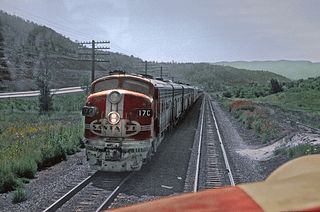
The Chief was an American long-distance named passenger train of the Atchison, Topeka and Santa Fe Railway that ran between Chicago, Illinois and Los Angeles, California. The Santa Fe initiated the Chief in 1926 to supplement the California Limited. In 1936 the Super Chief was introduced, after the Super Chief was relaunched in 1948 with daily departures from LA and Chicago it gradually eclipsed the Chief as the standard bearer of the Santa Fe because of its timetable oriented to the Raton Pass transit. For some the Chief and San Francisco Chief as deluxe integrated trains with both Pullman sleepers and fully reclining coach seating with all facilities; lounges and pleasure domes, available to all passengers were at least equal flagships better suited to the business and executive market. From the mid 1960s the super Chief was only a small entirely separate section of the El Capitan seated vista train, the El Capitan passengers having no access to the Super Chiefs expensive eateries and bars which selling point was exclusion and service. The Chief was discontinued in 1968 due to high operating costs, competition from airlines, and the loss of Postal Office contracts.

The Capitol Limited was an American passenger train run by the Baltimore and Ohio Railroad, originally between New York City and Grand Central Station in Chicago, via Washington Union Station in Washington, D.C., Camden Station in Baltimore, and Pittsburgh. For almost 48 years, it was the B&O's flagship passenger train, noted for personalized service and innovation. At the time of its discontinuation on May 1, 1971, when Amtrak took over most rail passenger service in the U.S., the Capitol Limited operated between Washington and Chicago.

The Columbian was a named passenger train operated by the Baltimore and Ohio Railroad. It was the all-coach supplemental train of the all-Pullman Capitol Limited. It operated from 1931 to 1964. The train's initial route was between Jersey City, New Jersey and Washington, D.C., but in 1941 the Columbian route was lengthened to Jersey City – Chicago, Illinois. It was the first air-conditioned train in the United States.

The Cincinnatian was a named passenger train operated by the Baltimore and Ohio Railroad (B&O). The B&O inaugurated service on January 19, 1947, with service between Baltimore, Maryland and Cincinnati, Ohio, carrying the number 75 westbound and 76 eastbound, essentially a truncated route of the National Limited which operated between Jersey City, New Jersey and St. Louis.

The George Washington was a named passenger train of the Chesapeake and Ohio Railway running between Cincinnati, Ohio and Washington, D.C. that operated from 1932, the 200th anniversary of the birth of George Washington, to 1974. A section divided from the main train at Gordonsville, Virginia and operated through Richmond to Phoebus, Virginia. From the west, a section originated in Louisville and joined at Ashland.

The Slumbercoach is an 85-foot-long, 24 single room, eight double room streamlined sleeping car. Built in 1956 by the Budd Company for the Chicago, Burlington and Quincy Railroad for service on the Denver Zephyr, subsequent orders were placed in 1958 and 1959 by the Baltimore and Ohio Railroad and Missouri Pacific Railroad for the Texas Eagle/National Limited, then in 1959 by the Northern Pacific Railway for its North Coast Limited and also the New York Central Railroad for use on the 20th Century Limited.

The National Limited was the premier train of the Baltimore and Ohio Railroad (B&O) on its route between Jersey City, New Jersey, and St. Louis, Missouri, with major station stops in Washington, D.C., and Cincinnati, Ohio. It operated from 1925 to 1971. For much of its life it offered exclusive all-Pullman service, and it was the first long-distance train to be entirely air-conditioned. The National Limited was one of many trains discontinued when Amtrak began operations on May 1, 1971. Amtrak revived the name for another New York–St. Louis service which did not use the B&O route.
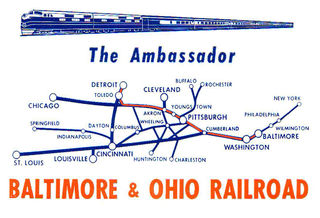
The Ambassador was a named train of the Baltimore and Ohio Railroad (B&O) on its route between Baltimore, Maryland and Detroit, Michigan with major station stops in Washington, D.C., and Pittsburgh, Pennsylvania, and Toledo, Ohio. Inaugurated in 1930, the Ambassador was discontinued in 1964.
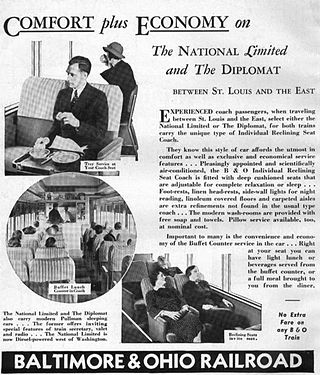
The Diplomat was a named passenger train of the Baltimore and Ohio Railroad (B&O) during the 1930s–1950s connecting New York City and St. Louis, Missouri, via Washington, D.C. Other B&O trains on the route during that period were the premier National Limited and the workhorse Metropolitan Special. The train was inaugurated in August 1930 after several changes to trains along the St. Louis Route. After World War II, the Diplomat operated as Train No. 3 westbound, and No. 4 eastbound. It was timed to provide connections to several western railroads that terminated in St. Louis, including the Frisco, the Santa Fe, Cotton Belt and Missouri Pacific, among others.

The Washington–Chicago Express, an American named passenger train of the Baltimore and Ohio Railroad (B&O), was one of four daily B&O trains operating between Washington, D.C., and Chicago, Illinois, via Pittsburgh, Pennsylvania during the 1930s–1960s. Other B&O trains of that period on the route were the Capitol Limited, Columbian, and the Shenandoah.
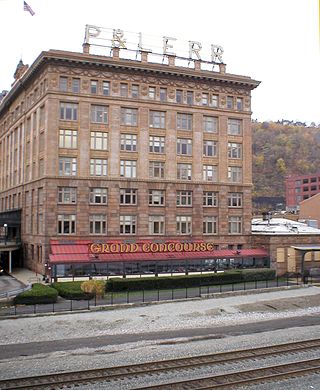
The Pittsburgh & Lake Erie Railroad Station, now Landry's Grand Concourse restaurant in Station Square Plaza in Pittsburgh, Pennsylvania, is an historic building that was erected in 1898. It was listed on the National Register of Historic Places in 1974.
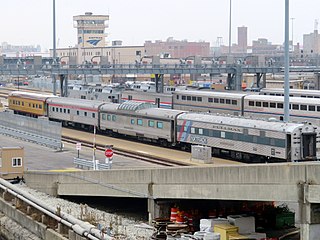
The Strata-Domes were a fleet of five streamlined dome cars operated by the Baltimore and Ohio Railroad ("B&O"). The term referred both to a pair of dome cars constructed by Pullman-Standard and three Budd Company domes the B&O acquired from the Chesapeake and Ohio Railway ("C&O"). They were the first dome cars operated in the Eastern United States, following on the success of the Chicago, Burlington and Quincy Railroad's "Vista-Domes" in the west. The cars entered service in 1949 and were all out of regular service by 1981. Several have been preserved.

Akron Union Station was a series of three union stations serving several passenger railroads in Akron, Ohio from 1852 to 1971. The station's tenants included the Baltimore & Ohio Railroad, Pennsylvania Railroad and Erie Railroad. It was a hub, serving train companies serving destinations in different directions, west, north, south and east.
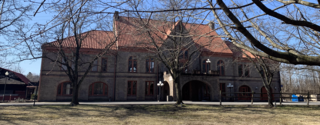
Youngstown station is a former passenger railroad station in Youngstown, Ohio. The station is on the ex Baltimore and Ohio Railroad, and was a B&O passenger station for most of the twentieth century. The station was built in 1905 and operated as a passenger station until 1971, when the B&O yielded passenger train service to Amtrak. It was later a passenger station for Amtrak through the 1990s and early 2000s.























